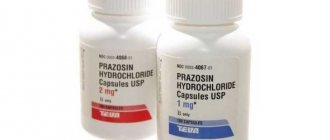How do ACE inhibitors work?
Speaking strictly scientifically, drugs of this pharmacological group block the action of the angiotensin-converting enzyme, which is necessary for the transformation of angiotensin I into angiotensin II. It is the latter that promotes vasospasm, which increases peripheral vascular resistance, as well as the production of aldosterone in the adrenal glands, which also causes fluid and sodium retention. Such changes, in fact, lead to an increase in blood pressure.
ACE is normally present in our blood (in its plasma component) and in tissues. It is this enzyme that is responsible for rapid vascular reactions, such as the response to stress. Plasma enzyme helps us to more easily endure shocks and emotional stress. And the tissue enzyme is responsible for long-term vascular reactions. Medications whose task is to block ACE must inactivate both enzymatic fractions at once. This means that their important feature is penetration into tissues with dissolution in fats. We can say that the effectiveness of a drug depends precisely on solubility.
It turns out that taking the medicine can provide: a decrease in peripheral vascular resistance, a decrease in the load on the heart, a decrease in blood pressure itself, optimization of blood flow in vessels of various importance, and a decrease in the risk of arrhythmic reactions.
One of the popular drugs of this pharmaceutical group is Ramipril, the indications for use of which are different, but one of the main ones is hypertension.
Recommendations
The use of Ramipril affects a person's concentration and attention. Therefore, while using this drug, it is not advisable to drive a vehicle or perform actions that require increased attention.
Also, if any surgical or dental intervention is expected while taking Ramipril, you must warn your doctor about taking this drug. This is due to the fact that Ramipril reduces the effectiveness of anesthesia.
You should be careful about insect bites while taking this medication. The active components of the drug increase the likelihood of developing severe allergic reactions to insect venoms.
. The drug Ramipril is one of the most effective drugs in the fight against the manifestations of hypertension
It has been tested several times, and each time it has confirmed its quality. However, this drug should not be used without a doctor’s prescription.
The drug Ramipril is one of the most effective drugs in the fight against the manifestations of hypertension. It has been tested several times, and each time it has confirmed its quality. However, this drug should not be used without a doctor’s prescription.
Pharmacodynamic profile
Liver enzymes allow the active substance ramipril to form a metabolite called ramiprilat - it is a long-acting ACE inhibitor. When taking the pills orally, the formation of angiotensin II is reduced and bradykinin accumulation is recorded. As a result, the vessels dilate and pressure levels decrease.
Ramipril also causes an increase in the activity of the prostaglandin system, as a result of which the synthesis of prostaglandins is predicted to increase, which, when entering into their function, trigger the formation of nitric oxide in endothelial cells. This leads to cardioprotective and endothelial protection.
In addition, angiotensin II triggers the production of aldosterone, therefore the use of the drug leads to a reduced production of this substance and a parallel increase in potassium ions in the serum part of the biofluid. When the level of angiotensin II in the biological fluid decreases, its suppressive effect in the production of the hormone renin is eliminated according to a feedback loop with negation, which leads, in fact, to the activation of plasma renin.
Basic moments:
- In hypertensive patients, taking the drug leads to a decrease in blood pressure without, it should be noted, a compensatory increase in heart rate;
- The drug significantly reduces the peripheral vascular resistance, almost without causing defects in blood flow in the kidneys and glomerular filtration properties;
- The antihypertensive effect develops 60-120 minutes after taking the pill, and the peak effect is observed after three to six hours, it is stable for about a day;
- If Ramipril is taken as a course, the antihypertensive effect will gradually increase, optimizing approximately by the third or fourth week of therapy, and will be prolonged;
- Abrupt refusal to take a pharmaceutical drug does not lead to the so-called withdrawal syndrome;
- In hypertensive patients, the ingredients of the medicinal product stop the further development of hypertrophy of the myocardium and vascular walls.
In patients with CHF, the pharmaceutical minimizes the afterload on the heart muscle, it normalizes the filling of the veins, normalizes the filling pressure of the left cardiac ventricle, which, as is easy to predict, reduces the preload on the heart. Doctors record an increase in cardiac output and its fraction in these patients, and they also note a more stable condition during physical activity.
The medication is also indicated for nephropathy, both of diabetic etiology and of other origin, the rate of negative dynamics of renal failure is seriously slowed down. For this reason, the need for hemodialysis and transplantation is significantly reduced.
Pharmacological properties
Pharmacodynamics
Ramipril has a hypotensive, natriuretic, cardioprotective effect, being a prodrug from which the active metabolite ramiprilat is synthesized in the body.
This substance slows down the formation of angiotensin II from circulating angiotensin I and the production of angiotensin II in tissues, and also inhibits the renin-angiotensin system in tissues, including in the vascular wall. Ramipril suppresses the release of norepinephrine from neuronal terminals and minimizes vasoconstrictor reactions resulting from increased neurohumoral activity. The drug reduces the degradation of bradykinin and the production of aldosterone.
The drug provides dilation of the renal vessels, as well as induction of reversal of left ventricular hypertrophy and pathological remodeling in the cardiovascular system. The pronounced cardioprotective effect is explained by the influence of ramipril on the biosynthesis of prostaglandins and stimulation of the production of nitric oxide in the endothelium.
When treated with ramipril, total peripheral vascular resistance decreases (mainly in the renal vessels). This phenomenon is less pronounced in internal organs, including the skin and liver, and insignificantly in the brain and muscle tissue. The drug also increases regional blood flow in these organs, increases fibrinogen levels and tissue sensitivity to insulin, promotes the production of tissue plasminogen activator, providing thrombolysis.
Pharmacokinetics
When taken orally, absorption reaches 50–60%. Eating does not affect the degree of absorption, but reduces the rate of absorption. The maximum concentration of ramipril is achieved 2–4 hours after administration. In the liver, the compound is metabolized to form the active metabolite ramiprilat (the intensity of ACE inhibition is 6 times higher than that of ramipril) and the inactive metabolite diketopiperazine. Ramipril then undergoes glucuronidation. With the exception of ramiprilat, all metabolites formed do not exhibit pharmacological activity.
Ramipril is bound to plasma proteins by 73%, and ramiprilat by 56%. Bioavailability after oral administration of 2.5–5 mg of the drug is 15–28%, in the case of ramiprilat – 45%. When taking the drug daily at a daily dose of 5 mg, a stable level of ramiprilat in the blood plasma is achieved by the 4th day.
The half-life of ramipril is 5.1 hours. The concentration of ramiprilat in the blood serum decreases in the distribution and elimination phase with a half-life of 3 hours, in the transition phase the half-life is 15 hours and in the long terminal phase, which is characterized by a very low plasma content of ramiprilat - 4-5 days. The half-life increases in patients suffering from chronic renal failure.
The volume of distribution of ramipril is 90 l, ramiprilat - 500 l. The substance is excreted through the kidneys in an amount of 60% of the dose taken, and through the intestines - in an amount of 40% (mainly in the form of metabolites). In case of kidney dysfunction, the rate of excretion of ramipril and its metabolites decreases in proportion to the decrease in creatinine clearance; in case of liver dysfunction, its conversion to ramiprilat is inhibited, and in case of heart failure, the content of ramiprilat increases by 1.5–1.8 times.
Pharmacokinetic profile
When taken orally, the medicinal composition is quickly absorbed from the digestive tract (50-60%). If you take it with food, the absorption of the drug will slow down, but this does not affect the completeness of absorption.
The main substance undergoes presystemic intensive metabolism and activation almost completely - by hydrolysis in the liver tissues. As a result, only one active metabolite, ramiprilat, is detected: its activation relative to ACE inhibition is approximately 6 times greater than the activity of ramipril itself. Thus, as a result of the metabolism of the active substance, diketopiperazine, which is pharmacologically inactive, is also formed: it is further conjugated with glucuronic acid.
The bioavailability of the main component is from 15 to 20%, and the main metabolite – up to 45%. After taking a dose, 39% of the radioactivity of ramipril is evacuated by the intestinal route, and 60% by the kidneys. And since ramipril can be administered intravenously in a hospital setting, with this administration, about 55% of the dose in the form of ramipril and metabolites is found in urine.
If the drug is taken in high dosage, impaired hepatofunction can lead to slow first-pass metabolism of the active substance to the active metabolite.
Compatibility with other medications
The simultaneous use of certain drugs can nullify the overall effectiveness of the drug inhibitor Ramipril, and can also lead to various undesirable consequences and complications. For this reason, therapy with Ramipril is unacceptable under such circumstances as:
- Hemofiltration or hemodialysis with simultaneous administration of special polyacrylonitrile cell membranes;
- Apheresis using dextran sulfate;
- Calcium salts or potassium collecting diuretics.
Hemofiltration or hemodialysis
Apheresis using dextran sulfate
Calcium salts or potassium-scavenging diuretics
The instructions for taking the drug warn about various cases of a special anaphylactic adverse reaction if all of the listed important points are violated. The drug should be used with extreme caution if the patient is taking hypnotics, analgesics, diuretics, allopurinol, systemic glucocorticosteroids, and immunosuppressants. The drug is taken under supervision while taking medications that affect blood counts.
Ramipril C3: who should take it?
The main indication, as already mentioned, is hypertension. In her case, the medicine is prescribed both as monotherapy and in combination with other antihypertensive medications (diuretics, Ca channel blockers).
The product is also prescribed:
- For CHF - only in a complex scheme;
- With diabetic nephropathy and other variations of pathology of different stages (and with marked proteinuria among them), in particular, if nephropathology goes along with hypertension;
- In case of HF with a clinical picture that developed shortly after myocardial infarction (MI);
- In order to level the threat of MI and stroke associated with cardiovascular pathologies.
The medication has a considerable number of contraindications.
Who should not take Ramipril?
Of course, taking it if you are hypersensitive to the components of the medication is prohibited. In particular, it should not be used by those who are lactase intolerant, because milk sugar is contained in the formula of the medication.
You should not take Ramipril if:
- History of angioedema – there is a risk of relapse;
- Hemodynamically significant stenosis of the renal vessels;
- Hypotension;
- Status with instability of hemodynamic markers;
- Severe renal failure/hemodialysis;
- CHF in the decompensatory stage;
- Primary hyperaldosteronism;
- Parallel use with angiotensin II receptor antagonists (for patients with nephropathy due to diabetes);
- Pregnancy and breastfeeding;
- Nephropathy, which is corrected with glucocorticosteroids, NSAIDs or immunomodulators;
- Hyposensitizing treatment for poisonous insect bites;
- Childhood of the patient;
- Apheresis of low-density lipoproteins with dextran sulfate, etc.
It is prohibited to take the described product for class IV CHF, unstable angina, life-threatening ventricular disorders of MS, and pulmonary heart syndrome.
Instructions
Before taking the medicine, you should read the manufacturer's recommendations. The instructions for use contain a list of reasons prohibiting the use of the drug. Exactly:
- Systemic diseases affecting connective tissue (lupus erythematosus, scleroderma).
- Individual intolerance to components, including impaired absorption of lactose.
- Diagnosed Quincke's edema or Quincke's edema that occurs earlier after taking ramipril-based drugs.
- Hypotonic disease.
- Problems with the liver or kidneys.
- Stenosis of the artery of a single/two kidneys, previous kidney transplant surgery.
- Decompensated heart failure.
- Excessive synthesis of aldosterone.
- Use in patients with diabetes mellitus receiving aliskeren and others.
The entire list is specified in the instructions for use. Do not forget to read the leaflet before medical use of the drug.
Ramipril is recommended for use in conditions characterized by high blood pressure, such as:
- Essential or primary acute or chronic hypertension;
- Complex effective therapy for CHF;
- Failure in the very first hours after a heart attack;
- Reducing the risk of myocardial infarction, dangerous stroke or sudden death from coronary or heart failure in people suffering from various heart pathologies.
Use with caution
This term refers to the conditionally acceptable use of Ramipril, but with a clear assessment of possible risks and conditions. Thus, this medication is prescribed with extreme caution for severe arterial hypertension, especially its malignant form. Taking medication for severe CHF, which is already corrected with antihypertensive drugs, is also questionable.
It is difficult to assess how the situation will change with hemodynamically important unilateral stenosis of the nephroartery - these patients can respond to even a slight increase in the concentration of creatinine in the serum with a unilateral deterioration in renal function.
If treatment with Ramipril was preceded by taking diuretic medications, this is not the best condition, so the doctor again has to evaluate all the risks and possibilities. Also, a history of diabetes mellitus, old age (as the risk of increased hypotensive action increases), hyperkalemia, as well as systemic ailments with connective tissue damage can be considered not the most favorable conditions for taking it.
With special attention, the doctor will select antihypertensive drugs for patients with a history of systemic lupus erythematosus, as well as scleroderma. Ramipril is also prescribed with all care to those patients who are being treated with medications that tend to deform the peripheral blood image.
Contraindications
Ramipril will not always have a positive effect on the human body. There are situations of its negative impact when the drug should be canceled and prohibited:
- allergy to components included in ACE inhibitors;
- low blood pressure;
- hyperkalemia;
- kidney failure;
- period of pregnancy and lactation.
Also, the drug is strictly prohibited for the treatment of children and adolescents under 18 years of age.
Contraindications
Use caution and limit the dose of medication for the following diseases:
- patient's history of Quincke's edema;
- severe degrees of autoimmune pathologies;
- atherosclerosis;
- problems with blood circulation;
- diabetes;
- rehabilitation after kidney transplantation;
- hyponatremia;
- some lung pathologies.
Gestation and lactation
The instructions for use of Ramipril indicate that the medication is prohibited for pregnant women, this is based on facts of negative effects on the fetus - destruction of the baby’s kidney development, a drop in his blood pressure, the development of hypoplasia of the cranial bones, contracture of the arms and legs, pulmonary hypoplasia, etc.
Even if a woman is not pregnant, but is at the stage of planning pregnancy, ACE inhibitors should be excluded. If pregnancy is detected in the patient during treatment with the drug, it is necessary to immediately stop therapy and transfer the patient to medications that are less dangerous for her condition.
If Ramipril is prescribed to a patient who is on breastfeeding, she has to suspend lactation. Feeding an infant while taking this medicine is unacceptable.
Indications for use
The medicine is prescribed for patients with the following diagnoses:
- hypertonic disease;
- chronic heart failure;
- diabetic nephropathy;
- reducing the risk of myocardial infarction and stroke;
- reduction of cases of coronary mortality due to cardiac ischemia.
The instructions stipulate that the medication can be used during the period of postoperative rehabilitation in order to restore the patient after surgery on the heart or blood vessels.
Ramipril for arterial hypertension
If arterial hypertension bothers a person constantly or very often, but at the same time he tries to adhere to the principles of a healthy lifestyle, then you need to consult a doctor for help without delaying this visit.
The doctor will immediately conduct an examination, prescribe an examination and make a diagnosis. Only after this is it permissible to begin treatment. Modern medicine cannot reliably establish the causes that provoke the development of hypertension. Currently, possible etiological factors include:
- wrong lifestyle;
- smoking;
- alcohol abuse;
- lack of physical activity;
- malnutrition, when there is a clear lack of vitamins and minerals in the diet;
- heredity;
- depressive states.
When the diagnosis has already been made and therapy with Ramipril has been prescribed, the pressure is under reliable control. Thanks to the characteristics of Ramipril, the blood pressure level begins to decrease already in the first days after the start of the course. During the entire treatment, no jumps or drops develop due to the strengthening and expanding vascular lumen effect of the active substance on the cardiovascular system.
Ramipril for hypertension
Under the influence of the action of Ramipril tablets on the body, the synthesis of auxiliary substances occurs in it, which resist high blood pressure even more than Ramipril itself. Thanks to this effect, the antihypertensive effect is doubled. Compared to other drugs, Ramipril is characterized by a prolonged action. It begins an hour after taking the tablet and continues for 2 days.
“Ramipril” allows you to prevent myocardial infarction, and if it has already occurred, the drug will protect the body from consequences in the form of necrosis of cells and tissues.
It is prohibited to treat with Ramipril during pregnancy due to the risk of pathological changes in the fetus. Before using the medication, women should be sure that they are not pregnant. If conception occurs during a course of treatment, therapy should be discontinued immediately. Then the doctor replaces the medicine with an analogue that is more gentle for the unborn child.
Dosage for hypertension
The tablets are not tied to a meal schedule. The main thing is to take the pill with at least half a glass of water. You should not chew it, just as you should not crush the medicine. The dose is selected by the doctor in accordance with the expected therapeutic effect, as well as data on the patient’s tolerability of the medication. Therapy is almost always long-term, but the duration is determined only by a specialist.
For hypertension:
- The starting dosage is 2.5 mg 1/24 in the morning, if within three weeks the desired effect cannot be achieved, the dose can be increased to 5 mg/day, if after another 2 weeks there is no progress, then it increases to 10 mg .
- As an alternative, you can consider the following scheme - other antihypertensive products, diuretics or slow calcium calcium blockers are added to Ramipril.
It is also worth considering the status of patients who will take this medicine. If the patient has nephropathology, then the initial daily dosage can be 1.25 mg, and the maximum is 5 mg.
Those patients whose lack of electrolytes and fluids is not properly corrected, as well as hypertensive patients with a severe or malignant form of the disease, should drink Ramipril at the same starting dosage - 1.25 mg. The same restrictions apply to patients aged 65+. Patients with hepatopathologies can begin therapy with 2.5 mg.
Instructions for use
The instructions for use clearly define the amount of medication. Use starts with a small amount - 25 mg. The dosage of the drug is gradually increased every three weeks and brought to 10 mg. In the first stages of treatment, take one tablet before meals, once a day. In some cases, two tablets are prescribed per day before meals.
For the elderly and patients with diabetes, the maximum amount of medication should not exceed 5 mg per day. Treatment begins with half a tablet, that is, with 1.25 mg.
Possible side effects
It has a number of side effects. Rarely, the following may occur:
- hypotension;
- angina pectoris;
- arrhythmias;
- myelosuppression;
- pancytopenia;
- thrombocytopenia;
- nausea and vomiting;
- stool disorders;
- dizziness;
- nonproductive cough;
- hives;
- prurigo.
Interaction with alcohol and drugs
Ramipril and alcohol are incompatible. When drinking alcohol, the effect of the medicine doubles, causing an excessive decrease in blood pressure, in some cases cardiac arrest and death are possible.
When combined with other drugs, the effect of Ramipril manifests itself differently. Its effect increases when combined with beta-blockers, analgesics, and diuretics.
Efficiency decreases when combined with nonsteroidal anti-inflammatory drugs, estrogens, and sympathomimetics.
The drug increases the percentage of lithium and digoskin, doubling their toxicity. When combined with potassium-sparing diuretics and potassium-containing supplements, hyperkalemia may develop. Combination with antidepressants leads to agranulocytosis, neutropenia with death.
Analogs
If the medicine is not suitable, the patient is prescribed analogues. Possible substitutes are:
- Amprilan.
- Corpril.
- Pyramid.
- Ramigamma.
- Ramitren.
- Tritace.
- Hartil.
What side effects may occur
They are indeed forecast with a certain frequency. There are cases when certain negative reactions are clearly identified, often, rarely or extremely rarely. But there are also situations with an undetected frequency.
Side effects of Ramipril:
- The immune system. Reactions of anaphylactic or anaphylactoid type, increased titer of antinuclear antibodies.
- Blood and lymphatic system. Eosinophilia is uncommon. Leukopenia with neutropenia and agranulocytosis are rare; there may be a deficiency of red blood cells in the biofluid, reduced hemoglobin and some other destruction of the hematopoietic system.
- Endocrine profile. The syndrome of inappropriate secretion of antidiuretic hormone is real with an unknown frequency.
- Psyche. Infrequently, depressed mood due to taking Ramipril, nervousness and anxiety of the motor plan, sleep disorders, lapses in consciousness are rarely recorded, and with an unknown frequency - failure of attention.
- CNS. Often a negative reaction is a headache, vertigo, a feeling of strange “lightness” in the head. There may be disruptions in taste perception. Tremor and coordination defects rarely occur. With an unknown frequency, cerebral ischemia is observed along with ischemic stroke and pathology of cerebral blood flow, paresthesia.
- Visual analyzer. Visual illusions with blurred images rarely occur. Conjunctivitis is rarely observed.
- Hearing. Ear ringing and persistent tinnitus are rarely recorded.
- Cardiovascular profile. Infrequently, myocardial ischemia with an attack of angina pectoris, MI, tachycardia, MS disorder, edema and palpitations are recorded. Often there is an increased decrease in blood pressure and syncope. Rarely, vasculitis is observed, with an unknown frequency - Raynaud's syndrome.
- Thorax and mediastinal organs. Often there is a dry cough, which tends to get worse at night, sinusitis and bronchitis, and shortness of breath. Bronchospasm with worsening bronchial asthma (if there is a history of it) and sinus congestion are not so common.
- Gastrointestinal tract. Inflammatory conditions in the digestive organs, a feeling of discomfort, diarrhea and nausea often occur, and vomiting may occur. Complicated pancreatitis is rarely recorded. Glossitis is rare.
- Liver and bile ducts. Infrequently, the activity of liver fermentation increases, and jaundice rarely occurs. With undetectable frequency - acute liver failure.
- Skin and pancreas. The medicine often causes a maculopapular skin rash. Infrequently provokes angioedema, hyperhidrosis and skin itching. Urticaria and exfoliative dermatitis are rarely reported. Complications of psoriasis and psoriasis-like dermatitis and other skin reactions occur with unknown frequency.
- Musculoskeletal system. Often myalgia and muscle cramps, infrequently arthralgia.
- Kidneys and urinary tract. Uncommon: impaired nephrofunction with the development of acute renal failure. The amount of urine produced may increase. It is possible that the level of creatinine and urea in the blood may increase.
- Organs of the reproductive system. Erectile dysfunction with undetectable frequency, problems with libido. The frequency of gynecomastia has not been determined.
- Other disorders. Chest pain and high fatigue are often recorded, and infrequently - an increase in body temperature. Asthenic syndrome is rarely observed.
Any adverse reaction is a reason to urgently consult a doctor for treatment adjustment.
Side effects
The following side effects may occur when taking Ramipril:
- from the cardiovascular system : sharp decrease in pressure, heart failure, heart attack, blood anemia, angina pectoris, chest pain;
- from the nervous system : dizziness and headaches, drowsiness, insomnia, depression, tremor, visual and auditory disturbances;
- from the gastrointestinal tract : nausea, vomiting, diarrhea, diarrhea, dry mouth, liver dysfunction, pancreatitis;
- from the genitourinary system: impotence, edema, renal dysfunction;
- from the respiratory system : respiratory tract infections, dry cough, bronchitis, laryngitis;
- from the skin : rash, urticaria, erythema;
- from other functions : anorexia, fever, anaphylactic reaction, edema of various origins.
Overdose
Typically, with an overdose, the victim’s blood pressure sharply decreases, shock and bradycardia are observed, as well as water and electrolyte imbalance. Acute renal failure and stupor are possible.
Treatment is carried out by gastric lavage, taking an adequate amount of adsorbents and sodium sulfate - if possible, within half an hour. In difficult cases, resuscitation therapy is needed, sometimes with the installation of a temporary pacemaker. Doctors also monitor serum creatinine levels and electrolytes.
special instructions
If renal function is impaired, dose adjustment is required in accordance with the creatinine clearance value. In this regard, before starting treatment, a study of kidney function is required, and subsequently monitoring of this indicator, as well as the electrolyte composition of the blood, liver enzymes, and peripheral blood patterns is carried out.
If there is a deficiency of fluid or sodium, correction of the water-electrolyte balance is necessary before prescribing the drug. During treatment, hemodialysis should not be performed using polyacrylonitrile membranes due to the risk of anaphylactic reactions.
What medications are not recommended for use with?
Combination therapy with Ramipril and potassium salts, potassium-sparing diuretics, as well as other medications that can increase potassium levels in the blood serum is not recommended.
Ramipril is combined with caution with other antihypertensive drugs (diuretics), as well as medications that can indirectly reduce blood pressure - these are nitrates, tricyclic antidepressants, anesthetics, etc. Also, be careful when combining drugs based on ramipril with sleeping pills and narcotics, painkillers, lithium salts and hypoglycemic medications.
You need to be careful about the following combinations:
- NSAIDs – possible weakened effect of ramipril and increased risk of renal pathologies;
- Heparin – an increase in the level of potassium in biological fluid is possible;
- Sodium chloride - may weaken the hypotensive effect;
- Estrogens – it is also possible that the hypotensive effect may decrease.
Whatever antihypertensive drug your doctor prescribes, be sure to tell him or her about everything you are taking. When treating colds and viral diseases, do not take medications “at random”; many, not at first glance, harmless medications can change the effect of Ramipril; some combinations are fraught with complications.
Interaction with other drugs
Concurrent use of drugs with vasodilator and diuretic effects, painkillers and anesthetics often enhances the antihypertensive effect. Anti-inflammatory drugs, on the contrary, reduce the antihypertensive effect. The interaction of Ramipril with drugs that contain lithium or potassium (vitamins, diuretics, psychotropic drugs), firstly, increases the average potassium content in the body, and secondly, it increases the level of toxicity of the active elements. Due to vasodilation, Ramipril can enhance the effect of alcohol on the central nervous system.
Ramipril's analogs
Ramipril and Hartil can be considered interchangeable drugs. Pyramil should be included in this category. Ramipril or Hartil - which is better, some patients wonder. It’s difficult to say for sure, because there are many conditions and remarks. But in a sense, Hartil is more effective, although it will cost more than its “colleague,” at least three times. Elanapril and Lisinopril can also be considered analogues.
The price of Ramipril ranges from 170-200 rubles for a standard package in a dosage of 2.5 mg tablets.
Ramipril price, where to buy
The price of Ramipril varies by region, however, on average, a package containing capsules or tablets has a nominal volume of 2.5 mg. will cost 200 rubles.
Find the nearest pharmacies
- Online pharmacies in RussiaRussia
- Online pharmacies in UkraineUkraine
- Online pharmacies in KazakhstanKazakhstan
Pharmacy Dialogue* discount 100 rub. using promo code medside (for orders over 1000 rubles)
- Ramipril (5 mg tablet No. 28)
107 rub.
- Ramipril-Akrikhin tablets 5 mg No. 30
136 rub.
- Ramipril-Akrikhin tablets 2.5 mg No. 30
125 rub.
show more
Pharmacy24
- Euroramipril N 5 mg/12.5 mg No. 20 tablets Pharma Start TOV, Ukraine
52.65 UAH.
- Euroramipril N 10 mg/12.5 mg No. 20 tablets Pharma Start TOV, Ukraine
74 UAH
PaniPharmacy
- Euroramipril N tablets Euroramipril N5 tablets. 5mg/12.5mg No. 20 Ukraine, Pharma Start LLC
68.8 UAH.
- Euroramipril N tablets Euroramipril N10 tablets. 10mg/12.5mg No. 20 Ukraine, Pharma Start LLC
92.63 UAH.
show more
BIOSPHERE
- Ramipril Viva Pharm 5 mg No. 30 tablet Viva Pharm TOO (Kazakhstan)
1 140 tenge.
- Ramipril Viva Pharm 10 mg No. 30 tablet Viva Pharm TOO (Kazakhstan)
1,485 tenge.
Reviews from real patients on Ramipril
The selection of a pharmaceutical drug is of a purely individual nature, therefore reviews cannot be considered information on the basis of which conclusions should be drawn. We warn you that any self-medication is fraught with serious deterioration of the condition with irreversible consequences.
Viktor Iosifovich: “In the second month of taking Ramipril, I was tormented by a dry cough. At first I didn’t associate it with the medicine, as long as I wasn’t treating it. The doctor said that this could happen. I was prescribed Hartil, the cough appeared in the same way in the second month, but it disappeared within a couple of days.”
Inga Luzhko: “I heard a lot of good reviews about Hartil, but none of my friends drank Ramipril. But the doctor recommended drinking it. The blood pressure became persistently normal (125/80) approximately in the third week of treatment. I’ve been taking it for a month and a half at a low dosage, with no plans for a break.”
Olga Sidorchenko: “I once accidentally, due to stress, forgot that I had already taken a pill in the morning, and took a second one again. I was so scared! But other than dizziness and slight blurred vision, nothing happened. They say it's not an overdose. In general, you need to drink such strong drugs with caution, I had to have an ultrasound of my kidneys, because I didn’t know how I was doing with them. We found a small problem - we’ll fix it.”
Ramipril is currently produced by a number of large pharmaceutical companies. Trade names for this product may vary. Ramipril has been sold for more than 20 years, but it cannot be said that the product became a sales leader in those years. Today it is appreciated - serious studies have shown that it helps reduce many cardiovascular risks.










